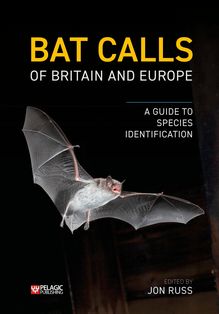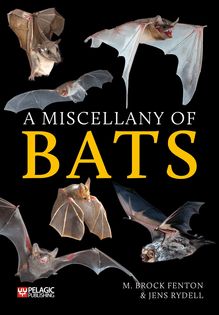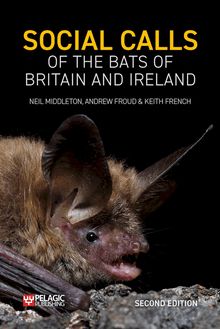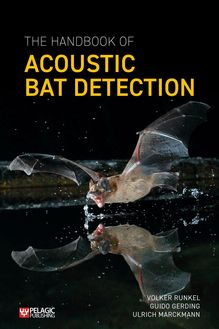-
 Univers
Univers
-
 Ebooks
Ebooks
-
 Livres audio
Livres audio
-
 Presse
Presse
-
 Podcasts
Podcasts
-
 BD
BD
-
 Documents
Documents
-
- Cours
- Révisions
- Ressources pédagogiques
- Sciences de l’éducation
- Manuels scolaires
- Langues
- Travaux de classe
- Annales de BEP
- Etudes supérieures
- Maternelle et primaire
- Fiches de lecture
- Orientation scolaire
- Méthodologie
- Corrigés de devoir
- Annales d’examens et concours
- Annales du bac
- Annales du brevet
- Rapports de stage
La lecture à portée de main
Vous pourrez modifier la taille du texte de cet ouvrage
Découvre YouScribe en t'inscrivant gratuitement
Je m'inscrisDécouvre YouScribe en t'inscrivant gratuitement
Je m'inscrisEn savoir plus
Vous pourrez modifier la taille du texte de cet ouvrage
En savoir plus

Description
A comprehensive guide to the calls of the 44 species of bat currently known to occur in Europe. Following on from the popular British Bat Calls by Jon Russ, this new book draws on the expertise of more than forty specialist authors to substantially update all sections, further expanding the volume to include sound analysis and species identification of all European bats.
Aimed at volunteers and professional alike, topics include the basics of sound, echolocation in bats, an introduction to acoustic communication, equipment used and call analysis. For each species, detailed information is given on distribution, emergence, flight and foraging behaviour, habitat, echolocation calls – including parameters of common measurements – and social calls.
Calls are described for both heterodyne and time expansion/full spectrum systems. A simple but complete echolocation guide to all species is provided for beginners, allowing them to analyse call sequences and arrive at the most likely species or group. The book also includes access to a downloadable library of over 450 calls presented as sonograms in the species sections.
1. Introduction
2. The Basics of Sound: Properties, Acquiring, Representing and Describing
3. Echolocation
4. An Introduction to Acoustic Communication in Bats
5. Equipment
6. Call Analysis
7. A Basic Echolocation Guide to Species 93
8. The Bat Species
References and Further Reading
Index
Sujets
Informations
| Publié par | Pelagic Publishing |
| Date de parution | 23 août 2021 |
| Nombre de lectures | 1 |
| EAN13 | 9781784272265 |
| Langue | English |
| Poids de l'ouvrage | 6 Mo |
Informations légales : prix de location à la page 0,3500€. Cette information est donnée uniquement à titre indicatif conformément à la législation en vigueur.
Extrait
Bat Calls of Britain and Europe
Bat Calls of Britain and Europe
A GUIDE TO SPECIES IDENTIFICATION
Edited by Jon Russ
PELAGIC PUBLISHING
Published by Pelagic Publishing PO Box 874 Exeter EX3 9BR UK
www.pelagicpublishing.com
Bat Calls of Britain and Europe: A Guide to Species Identification
ISBN 978-1-78427-225-8 Hardback ISBN 978-1-78427-226-5 ePub ISBN 978-1-78427-227-2 PDF
Copyright © 2021 Jon Russ and Francisco Amorim, Leonardo Ancillotto, Maggie Andrews, Peter Andrews, Kate Barlow, Yves Bas, Arjan Boonman, Martijn Boonman, Philip Briggs, Erika Dahlberg, Johan Eklöf, Péter Estók, Gaetano Fichera, Jeremy Froidevaux, Joanna Furmankiewicz, Panagiotis Georgiakakis, Clara Gonzalez Hernandez, Julia Hafner, Daniela Hamidović, Amelia Hodnett, Pedro Horta, Artemis Kafkaletou-Diez, Andreas Kiefer, Erik Korsten, Alex Lefevre, Mauro Mucedda, Stephanie Murphy, Jorge M. Palmeirim, Eleni Papadatou, Ricardo Pérez-Rodríguez, Ermanno Pidinchedda, Ana Rainho, Helena Raposeira, Orly Razgour, Hugo Rebelo, Dina Rnjak, Charlotte Roemer, Danilo Russo, Jens Rydell, Horst Schauer-Weisshahn, Grace Smarsh, Claude Steck, Sérgio Teixeira, Marc Van De Sijpe, Carola van den Tempel.
The moral rights of the authors have been asserted.
All rights reserved. Apart from short excerpts for use in research or for reviews, no part of this document may be printed or reproduced, stored in a retrieval system, or transmitted in any form or by any means, electronic, mechanical, photocopying, recording, now known or hereafter invented or otherwise without prior permission from the publisher.
A CIP record for this book is available from the British Library
Front cover: Daubenton’s bat Myotis daubentonii © Jens Rydell Rear cover: Brown long-eared bat Plecotus auritus © René Janssen
Typeset by BBR Design, Sheffield
Contents
Preface and Acknowledgements
1. Introduction
2. The Basics of Sound: Properties, Acquiring, Representing and Describing
2.1 Properties of sound
2.2 Signal acquisition
2.3 Representing and describing sound
3. Echolocation
3.1 Why did echolocation evolve mainly in bats?
3.2 Extant echolocation types
3.3 Echolocation types of European bats and their function
3.4 The function of pulse duration
3.5 Why do bats have specific echolocation frequencies?
3.6 The function of FM pulses
3.7 Multiple-harmonic FM
3.8 Flexibility of echolocation
3.9 A viable strategy for identifying sonar calls of bats
4. An Introduction to Acoustic Communication in Bats
4.1 Technological constraints and observer bias
4.2 Understanding and describing bat acoustic repertoires
4.3 Common types of communication calls
4.4 Selective pressures and constraints on communication signals
4.5 Environmental pressure
4.6 Energetic constraints
4.7 Signal variability and stability: acoustic signatures versus motivational cues
4.8 Conclusion
5. Equipment
5.1 A history of bat-detector research
5.2 Bat detectors
5.3 Microphones, frequency ranges and detection ranges
5.4 Recording sound
5.5 Automated identification of bat calls
5.6 Passive recording
6. Call Analysis
6.1 Sound-analysis software
6.2 Automatic recognition software
6.3 Using sound-analysis software
6.4 Measuring call parameters
6.5 Zero-crossing analysis
6.6 Common analysis problems
7. A Basic Echolocation Guide to Species
8. The Bat Species
8.1 Lesser horseshoe bat
8.2 Greater horseshoe bat
8.3 Mediterranean horseshoe bat
8.4 Mehely’s horseshoe bat
8.5 Blasius’s horseshoe bat
8.6 Daubenton’s bat
8.7 Pond bat
8.8 Long-fingered bat
8.9 Brandt’s bat
8.10 Whiskered bat
8.11 David’s myotis
8.12 Alcathoe whiskered bat
8.13 Geoffroy’s bat
8.14 Natterer’s bat
8.15 Cryptic myotis
8.16 Iberian Natterer’s bat
8.17 Bechstein’s bat
8.18 Greater mouse-eared bat
8.19 Lesser mouse-eared bat
8.20 Maghreb mouse-eared bat
8.21 Noctule
8.22 Greater noctule
8.23 Leisler’s bat
8.24 Azorean noctule
8.25 Serotine
8.26 Meridional serotine
8.27 Anatolian serotine
8.28 Northern bat
8.29 Parti-coloured bat
8.30 Common pipistrelle
8.31 Soprano pipistrelle
8.32 Hanak’s pipistrelle
8.33 Nathusius’s pipistrelle
8.34 Kuhl’s pipistrelle
8.35 Madeira pipistrelle
8.36 Savi’s pipistrelle
8.37 Western barbastelle
8.38 Brown long-eared bat
8.39 Alpine long-eared bat
8.40 Sardinian long-eared bat
8.41 Grey long-eared bat
8.42 Mediterranean long-eared bat
8.43 Schreiber’s bent-winged bat
8.44 European free-tailed bat
References and Further Reading
Index
About the Editor
Jon Russ first became interested in bats in 1994 while completing research on pipistrelle social calls as part of a degree in zoology at the University of Aberdeen. This led to a PhD at Queen’s University Belfast investigating the community composition, habitat associations and echolocation calls of Northern Ireland’s bats. Since then he has been involved in a wide variety of bat-related projects which have taken him from the freezing rain of northeast Scotland and the fine soft nights of Ireland to the humid rainforests of Madagascar, Thailand and Myanmar. Jon is the Director of Ridgeway Ecology Ltd, a specialist bat consultancy, and for several years he worked for the Bat Conservation Trust coordinating the iBats project in the UK and eastern Europe. He has written a large number of articles in scientific journals, and his other publications include the widely used book British Bat Calls: A Guide to Species Identification published by Pelagic Publishing. After more than 25 years of involvement in bat research and conservation, he continues to be fascinated by these remarkable mammals.
Preface and Acknowledgements
Following the surprising success of British Bat Calls , published in 2012, Nigel Massen of Pelagic Publishing kindly waited a few years before tentatively suggesting I collate a European version of the book. My immediate reaction was very positive – it would be a simple matter to ‘crowbar in’ the other species and I could probably have the whole thing wrapped up in six months. However, it soon became clear that I was being a little bit naive, and that incorporating 22 additional species (plus four that were added to the European list during the writing of this book) was well outside the scope of my experience – and available time. After shelving the idea for around a year it occurred to me that it would be better to identify people who record and come into contact with those species for which I have limited or no knowledge and ask them to write the chapters instead. Taking up the role of editor as well as author, I began the task of finding volunteers, researchers and enthusiasts from around Europe who were willing to give up their time to assist with the project. It did not take as long as anticipated, and thanks to the excellent network of bat workers throughout Europe, I soon had a list of contributors – and from then on the book began to take shape. Although at times it felt as if I was manoeuvring a large oil tanker into a small harbour, I think it has been well worth the effort by all involved. I hope it will be useful to volunteers and professionals alike.
This book would not have been possible without the efforts of all the authors who have given their valuable time and expertise. I have been overwhelmed by the generosity of my co-authors and cannot thank them enough. They are listed in the separate chapters and species sections, but all of them deserve a mention here. I am extremely grateful to Arjan Boonman for Chapter 3 ( Echolocation ), Grace Smarsh for Chapter 4 ( An Introduction to Acoustic Communication in Bats ), Philip Briggs, Arjan Boonman, Martijn Boonman, Jeremy Froidevaux and Kate Barlow for Chapter 5 ( Equipment ), Kate Barlow and Philip Briggs for Chapter 6 ( Call Analysis ) and Yves Bas, Charlotte Roemer, Arjan Boonman, Alex Lefevre and Marc Van De Sijpe for Chapter 7 ( A Basic Echolocation Guide to Species ). The species accounts in Chapter 8 were written by Francisco Amorim, Leonardo Ancillotto, Maggie Andrews, Peter Andrews, Arjan Boonman, Erika Dahlberg, Johan Eklöf, Péter Estók, Gaetano Fichera, Joanna Furmankiewicz, Panagiotis Georgiakakis, Clara Gonzalez Hernandez, Julia Hafner, Daniela Hamidović, Amelia Hodnett, Pedro Horta, Artemis Kafkaletou-Diez, Andreas Kiefer, Erik Korsten, Alex Lefevre, Mauro Mucedda, Stephanie Murphy, Jorge M. Palmeirim, Eleni Papadatou, Ricardo Pérez-Rodríguez, Ermanno Pidinchedda, Ana Rainho, Helena Raposeira, Orly Razgour, Hugo Rebelo, Dina Rnjak, Danilo Russo, Jens Rydell, Horst Schauer-Weisshahn, Claude Steck, Sérgio Teixeira, Marc Van De Sijpe, Carola van den Tempel and myself.
I would like to thank (again) Marc Van De Sijpe and Alex Lefevre. Not only have they contributed to more than their fair share of the species chapters, as well as helping to write the basic echolocation identification guide, they have also unhesitatingly and generously provided me with hundreds of echolocation and social calls, which have vastly improved the book. They were always available to help when I was struggling with a particular species, and if they didn’t have calls themselves they would find someone who did. Their knowledge of European bat species has been a rich seam to mine, and the book would have been much poorer without their input.
Arjan Boonman assisted enormously from the very beginning with his great technical knowledge – and he put me in touch with Grace Smarsh, who vastly improved the acoustic communication chapter from my section on this topic in the British Bat Calls book.
Many people were kind enough to provide echolocation and social calls: Daniel Fernández Alonso, Francisco Amorin, Leonardo Ancillotto, Maggie Andrews, Paulo Barros, Yves Bas, Yannick Beucher, Kirsten Bohn, Arjan Boonman, Erika Dahlberg, Jonathan Demaret, Christian Diez, Simon Dutilleul, Bengt Edqvist, Péter Estók, Rich Flight, Joanna Furmankiewicz, Panagiotis G
-
 Univers
Univers
-
 Ebooks
Ebooks
-
 Livres audio
Livres audio
-
 Presse
Presse
-
 Podcasts
Podcasts
-
 BD
BD
-
 Documents
Documents
-
Jeunesse
-
Littérature
-
Ressources professionnelles
-
Santé et bien-être
-
Savoirs
-
Education
-
Loisirs et hobbies
-
Art, musique et cinéma
-
Actualité et débat de société
-
Jeunesse
-
Littérature
-
Ressources professionnelles
-
Santé et bien-être
-
Savoirs
-
Education
-
Loisirs et hobbies
-
Art, musique et cinéma
-
Actualité et débat de société
-
Actualités
-
Lifestyle
-
Presse jeunesse
-
Presse professionnelle
-
Pratique
-
Presse sportive
-
Presse internationale
-
Culture & Médias
-
Action et Aventures
-
Science-fiction et Fantasy
-
Société
-
Jeunesse
-
Littérature
-
Ressources professionnelles
-
Santé et bien-être
-
Savoirs
-
Education
-
Loisirs et hobbies
-
Art, musique et cinéma
-
Actualité et débat de société
- Cours
- Révisions
- Ressources pédagogiques
- Sciences de l’éducation
- Manuels scolaires
- Langues
- Travaux de classe
- Annales de BEP
- Etudes supérieures
- Maternelle et primaire
- Fiches de lecture
- Orientation scolaire
- Méthodologie
- Corrigés de devoir
- Annales d’examens et concours
- Annales du bac
- Annales du brevet
- Rapports de stage










